Flooring Types and How To Choose?
There are hundreds of different flooring styles that you can choose from. In this article, we will take a look at some of the most popular ones, try to expose the advantages and disadvantages each of them brings to the table and hopefully help you find the ideal solution for you.
Hardwood Flooring
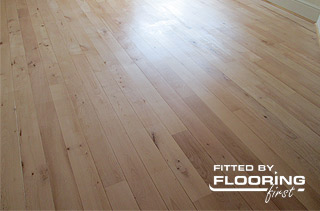 Hardwood flooring is the most expensive one on the market right now and for a good reason – It has unique qualities no other product can offer. Even more so – wood is a timeless classic made from natural materials. In the past, wooden floors were a luxury reserved only for the aristocracy until modern industry allowed the average person to have them in his home. Over the years, there have been many attempts to find a better alternative and they have all failed. Hardwood has remained the most desired flooring solution to this day. The list of benefits is rather long so we will cover only the most important ones.
Hardwood flooring is the most expensive one on the market right now and for a good reason – It has unique qualities no other product can offer. Even more so – wood is a timeless classic made from natural materials. In the past, wooden floors were a luxury reserved only for the aristocracy until modern industry allowed the average person to have them in his home. Over the years, there have been many attempts to find a better alternative and they have all failed. Hardwood has remained the most desired flooring solution to this day. The list of benefits is rather long so we will cover only the most important ones.
Natural. Wood flooring doesn’t contain any VOCs (Volatile Organic Compounds) nor does it emit any harmful chemicals throughout its life (unlike some synthetic alternatives like vinyl). Children and people suffering from allergies may find this a particularly useful trait.
Lasting. You can buy a laminate or vinyl and they will serve you for around 20, maybe 30 years if they are of good quality. Once they become worn and distressed, there is no going back. You have to get rid of them for good. Hardwood, on the other hand, can be sanded and refinished multiple times. There are wooden floors of over 300+ years and a modern one can last around 100 if you maintain it properly. The sanding process does not simply make the floor look as good as new but also improves its health.
Durable. Modern floor finishes and lacquers, in particular, are incredibly tough. However, if they get scratched or distressed you can always remove them and apply a completely new finish. The sanding process does not simply make the floor look as good as new but also improves its health. A quality finish can last up to 10 years if it is given enough attention. Of course, this depends a lot on the amount of traffic and conditions in the area. Combine it with the fact that a solid ¾- inch board can be sanded around 10 times and you can already see what makes this kind of flooring so desirable.
Wood floors can be divided into two major groups – solid and engineered. As the name implies, solid hardwood boards are created from a single “solid” piece of timber. This consistent structure allows them to be sanded much more often, endure more damage and generally last longer than engineered floors. Usually, comes with a tongue and groove system but in rare cases, you may find click installations.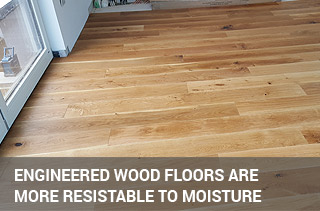
Engineered flooring is made from multiple layers of ply with a hardwood veneer on top. They work very well with underfloor heating and can be installed even in places where solid wood would be a bad choice for bathrooms or kitchens. The unique structure of engineered floors makes them better capable of withstanding changes in moisture and temperature.
Engineered flooring is made from multiple layers of ply with a hardwood veneer on top. They work very well with underfloor heating and can be installed even in places where solid wood would be a bad choice for bathrooms or kitchens. The unique structure of engineered floors makes them better capable of withstanding changes in moisture and temperature. The fact that they are cheaper than solid flooring also contributes to their popularity.
The biggest downside of hardwood floors is their weakness in moisture. There are many ways to deal with it, including the installation of a vapour barrier or a damp-proof membrane but the truth is that wood is vulnerable to it and even engineered flooring isn’t completely resistant. In the end, hardwood is attractive, stylish and practical. Its few downsides pale in comparison to the benefits.
Bamboo Flooring
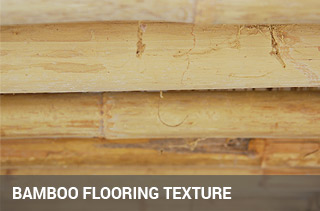 It is debatable if bamboo is a type of hardwood flooring because it is, in fact, grass. It is a renewable resource that only takes 5 years to fully grow while a tree takes decades. Bamboo is a controversial product because the quality offered varies greatly. Some people bought cheap bamboo flooring only to find out the hard way, that it is garbage. Others went for more expensive bamboo and praised its durability, claiming it is better than regular hardwood. What is the truth? How good or bad is bamboo?
It is debatable if bamboo is a type of hardwood flooring because it is, in fact, grass. It is a renewable resource that only takes 5 years to fully grow while a tree takes decades. Bamboo is a controversial product because the quality offered varies greatly. Some people bought cheap bamboo flooring only to find out the hard way, that it is garbage. Others went for more expensive bamboo and praised its durability, claiming it is better than regular hardwood. What is the truth? How good or bad is bamboo?
There are four types of bamboo – traditional, strand woven, solid and engineered bamboo. To explain the difference between those, we will talk a bit about the Janka hardness test. The Janka test is a method of measuring the resistance of wood species to wear and denting. Thus, we can determine how tough a flooring material is.
Traditional bamboo is made by slicing the cane of the grass, turning it into thin planks and nailing those planks to wooden beams. Stilted houses in South Asia are built that way. The strength of natural bamboo 1,380 lbf. For comparison, an English Oak only has 1,120 lbf.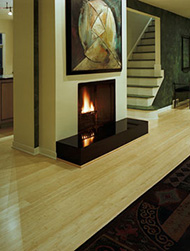
Strand woven bamboo is created from bamboo fibres compressed under extreme heat and combined with resin to make a plank. They are extremely tough with a hardness rating of exactly 3000 lbf (even exotic hardwood species rarely reach similar numbers).
Solid bamboo is manufactured by cutting thin strips from the stalks of the grass, boiling them in boric acid, drying and glueing them together horizontally or vertically to compress them and form a plank.
Engineered bamboo is created similarly to solid one but after the plank is formed, it is then cut into layers and glued on top of the plywood core under high heat and pressure.
Overall, the quality of bamboo varies greatly and some manufacturers could be using adhesives containing high amounts of VOCs. Bamboo, and more specifically strand woven bamboo is very tough and certainly has a lot to offer. Make sure you purchase from trustworthy sources and the product will prove to be a fine investment.
Laminate Flooring
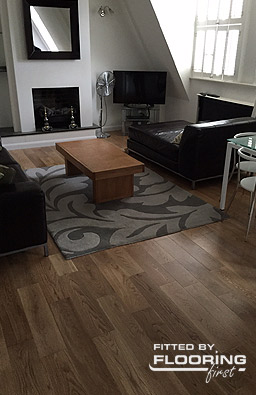 Laminate is a man-made product known mostly for its low price compared to other types of flooring. However, besides that, it has an incredibly tough wear layer capable of taking significant amounts of damage. Laminate is also hard to scratch or burn, stain-resistant and can even be made waterproof. This allows it to be used in kitchens and bathrooms without any trouble.
Laminate is a man-made product known mostly for its low price compared to other types of flooring. However, besides that, it has an incredibly tough wear layer capable of taking significant amounts of damage. Laminate is also hard to scratch or burn, stain-resistant and can even be made waterproof. This allows it to be used in kitchens and bathrooms without any trouble.
Laminate flooring consists of four main layers. First, we have a very strong overlay which provides very good protection against any kind of surface damage. The second is the decorative layer containing a printed image of some natural material – wood, stone or other. Modern laminates have become quite good at imitation. The third is the high-density fiberboard core made from chips of wood mixed with sawdust, turned into sheets and glued together at a high temperature.
Most, but not all laminates also have an additional back layer added to protect the core from moisture. Some people compare engineered hardwood to laminate because those two have a similar multilayered structure - there is no place for comparison. Engineered floors have a natural hardwood veneer while laminates possess only chips of real wood!
Laminate flooring has its fans but unlike hardwood, it can never be refinished. Once its overlay is penetrated, it is over. Pretty much everywhere where you can put a laminate, you can also use engineered hardwood. It also has to be considered that cheap laminates are usually of poor quality and break easily. More expensive ones are not that much cheaper than engineered wood. This again brings the question – Why use laminate at all then?
There are some quality laminates from companies like Quick-Step which can offer products with a guarantee of 20-25 years but this comes at the appropriate price. Quality never comes for free so beware of cheap imitations!
Ceramic Tile Flooring
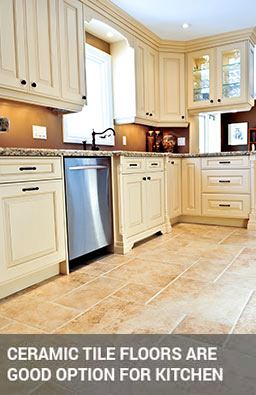 Tile flooring is made from clay mixed with a lot of water and other materials, shaped into a tile, put in a kiln and heated under certain conditions. However, this only creates the “body” of the tile. There also exists a technique called “glazing” which fuses an additional layer of coating that can make the tile impervious to water as well as provide decorative effects. Based on the availability or lack of glaze, you can recognize several types of tile - glazed, unglazed, single or double-glazed. Naturally, the biggest difference lies between the glazed and unglazed alternatives. The latter option is vulnerable to moisture and stain damage since it lacks protection on top. It must be sealed to be of any use in a bathroom or kitchen.
Tile flooring is made from clay mixed with a lot of water and other materials, shaped into a tile, put in a kiln and heated under certain conditions. However, this only creates the “body” of the tile. There also exists a technique called “glazing” which fuses an additional layer of coating that can make the tile impervious to water as well as provide decorative effects. Based on the availability or lack of glaze, you can recognize several types of tile - glazed, unglazed, single or double-glazed. Naturally, the biggest difference lies between the glazed and unglazed alternatives. The latter option is vulnerable to moisture and stain damage since it lacks protection on top. It must be sealed to be of any use in a bathroom or kitchen.
What do ceramic tiles offer? What would make you pick them over any of the rest?
Durable. This is a hard surface material and as such, it is extremely tough. It can last more than a few decades if you take good care of it and is hard to crack.
Medium cost. Well, when it comes to prices, ceramic tiles are somewhere in the middle. They cost more than other flooring types but less than hardwood.
Cleaning and maintenance. It is a waterproof material that cannot be scratched … What more to say? Cleaning cannot get any easier than this.
The downsides of this type of flooring are mostly when it comes to comfort and warmth. Or should we say the lack of them? Ceramic tiles are a hard material that doesn’t exactly feel cosy or welcoming. It is cold to the touch and doesn’t feel exactly comfortable on the feet, especially during the winter. Tiles will do a great job in places where moisture can be an issue like bathrooms but hardly anywhere else unless you don’t mind the discomforts that come with it.
LVT Flooring
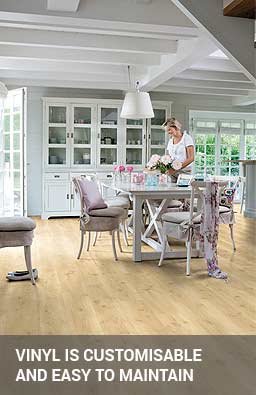 LVT flooring (Luxury Vinyl Tile) is one of the most versatile and modern synthetic flooring options available today. Designed for both performance and style, LVT is perfect for virtually any room — from busy kitchens and stylish living areas to moisture-prone bathrooms and utility rooms.
LVT flooring (Luxury Vinyl Tile) is one of the most versatile and modern synthetic flooring options available today. Designed for both performance and style, LVT is perfect for virtually any room — from busy kitchens and stylish living areas to moisture-prone bathrooms and utility rooms.
Highly Customisable. One of LVT’s biggest advantages is its broad selection of colours, textures, and finishes. Whether you prefer a realistic wood plank, a bold herringbone pattern, or a stone-look tile, LVT can match your taste and interior design effortlessly.
Impressive Durability. With proper installation and care, LVT floors can last 15–20 years or more. While it isn’t refinished like real wood, damaged tiles or planks can usually be replaced individually. It’s tough enough to withstand high foot traffic but can still be susceptible to cuts from sharp objects, so a little caution is advised.
Soft and Comfortable Underfoot. Compared to hard tiles or stone, LVT provides a warmer, cushioned walking experience — especially when installed with an underlay or built-in foam backing. This makes it ideal for homes where comfort matters.
100% Waterproof. LVT’s water resistance makes it a standout choice for wet areas like bathrooms, kitchens, and utility rooms. It handles spills and splashes with ease — no warping or swelling like traditional wood floors.
Low Maintenance. Thanks to its wear layer, LVT resists stains, scratches, and everyday dirt. A simple routine of sweeping and occasional damp mopping is all it takes to keep your floors looking like new.
Cost-Effective. LVT offers excellent value for money. While budget ranges are available, investing in higher-quality LVT ensures longer life, greater realism, and better comfort. It's often compared to laminate flooring but generally offers superior waterproofing and longevity.
Health Considerations. Like many synthetic materials, LVT may emit VOCs (volatile organic compounds), especially lower-end products. Always choose high-quality, low-VOC certified flooring when air quality is a concern. For this reason, LVT might not be the best choice for young children’s bedrooms, but it's a safe, practical solution for most other areas.
All in all, LVT is a stylish, durable, and versatile flooring option that performs exceptionally well across a wide range of spaces. Learn more about our LVT floor installation services in London.
Frequently Asked Questions About Flooring Types and Choosing the Right One
What are the main types of flooring you offer?
We supply and install a wide range of flooring options, including solid wood, engineered wood, parquet, laminate, and LVT (luxury vinyl tiles). Each has unique benefits suited to different needs and spaces.
Which flooring is best for London homes?
It depends on the property and lifestyle. Engineered wood is great for stability, LVT is ideal for busy households and moisture-prone areas, parquet adds elegance, and solid wood offers timeless charm.
What’s the most durable flooring option?
LVT and laminate are extremely durable and resistant to scratches and stains, making them ideal for families and high-traffic areas. Engineered and solid wood floors are long-lasting with proper care and refinishing.
Which flooring works best with underfloor heating?
Engineered wood and LVT are the best options for underfloor heating, as they handle temperature fluctuations better than solid wood.
How do I choose the right flooring for each room?
For kitchens and bathrooms, LVT works best due to its water resistance. For living rooms and bedrooms, engineered or solid wood adds warmth and elegance. Hallways benefit from durable options like parquet or laminate.
Can you help me decide which floor suits my budget and style?
Yes — we offer personalised consultations to match your budget, interior style, and long-term needs, ensuring you make the best choice for your London home.